ASUS UX31A: Putting the Ultra in Ultrabooks
by Jarred Walton on August 28, 2012 9:00 AM EST- Posted in
- Laptops
- Intel
- Asus
- Ivy Bridge
- Zenbook Prime
- Ultrabook
ASUS UX31A: General Performance
Next up is our overview of general performance, and honestly outside of the laptop overview and LCD characteristics this is probably the most pertinent aspect of how the UX31A behaves in everyday use. You typically don’t buy an Ultrabook because you want the fastest laptop on the planet or for serious gaming. Those duties are for larger laptops that can house discrete GPUs and quad-core processors. Ultrabooks are about portability and everyday tasks like running Office, surfing the Internet, checking email, etc.—only they’re hopefully more responsive than regular laptops thanks to their SSDs. Here’s how the UX31A compares to other recently reviewed Ultrabooks, including the prototype Ivy Bridge Ultrabook from Intel.
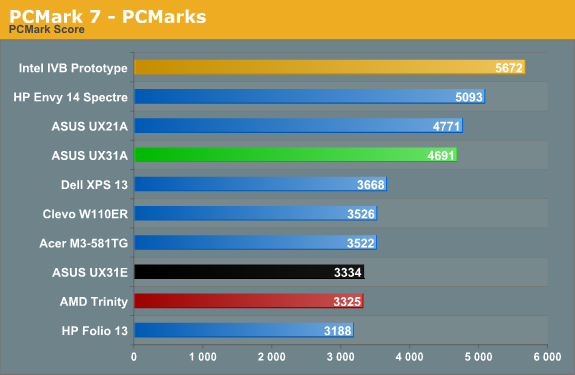
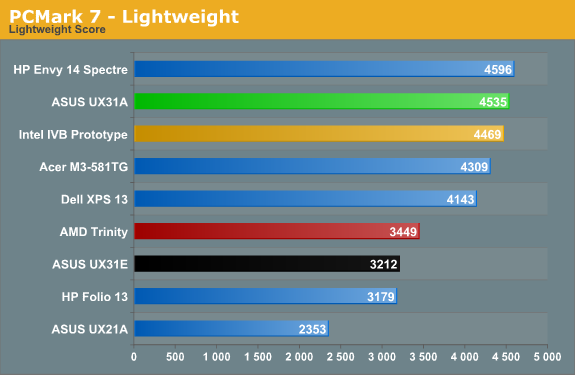

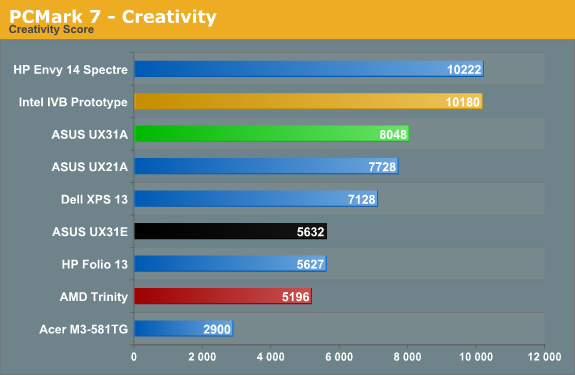
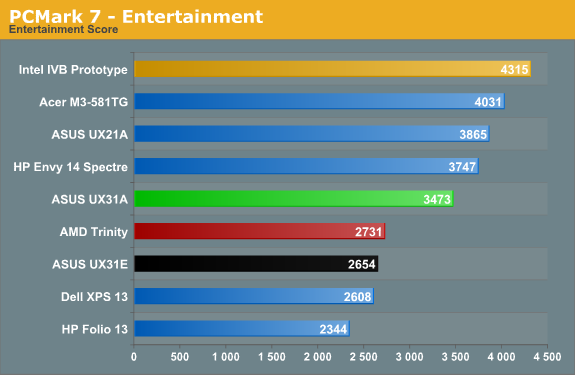
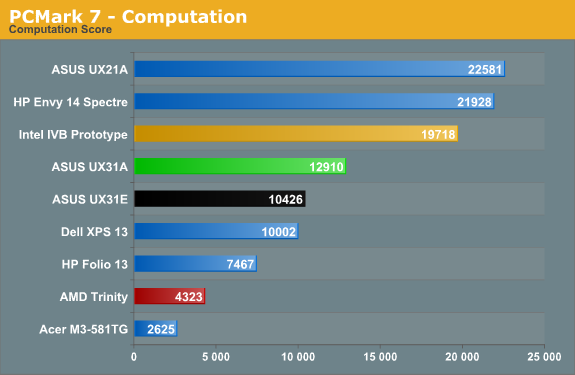
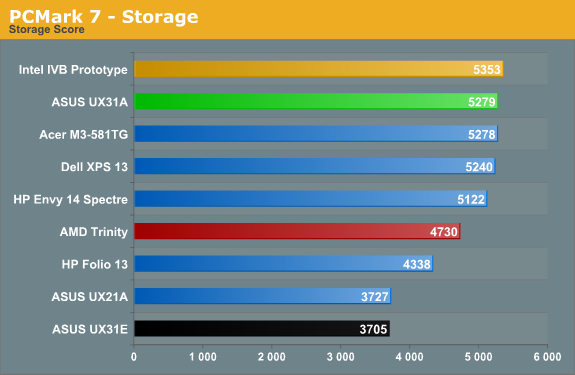
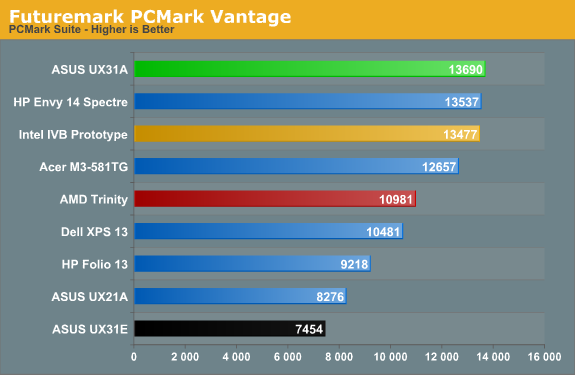
We’re looking at a faster i7-3517U processor compared to the i5-3427U in the last IVB Ultrabook, so naturally some of the scores are higher. PCMark 7 is extremely sensitive to storage performance for most of the tests, and the SF-2281 based SSDs are among the fastest out there (SandForce firmware issues notwithstanding, though I haven’t personally experienced any issues). But if the UX31A sports the fastest ULV processor we’ve tested so far and one of the fastest SSDs, why doesn’t it dominate all of the charts? The problem appears to be with the Intel GPU drivers; other IVB Ultrabooks and laptops have scored in the 20,000+ range in the Computation suite, thanks to Quick Sync, but the UX31A only manages just under 13K. ASUS shipped the UX31A with Intel’s latest 2761 driver set, and while I’ve seen good scores with those drivers I’ve also seen sub-par scores; this appears to be a case of the latter, and it brings down the Computation, Creativity, and Entertainment scores, which in turn affects the overall score as well. Don’t let those minor differences concern you, though: this is right up there with the fastest Ultrabooks.
PCMark Vantage doesn’t utilize Quick Sync, leveling the playing field quite a bit, and you can see that the UX31A tops that chart. Obviously, the difference isn’t all that great, but we wouldn’t expect it to be. The i7-3517U comes with a base clock just 100MHz higher and a max Turbo clock that’s 200MHz higher than the i5-3427U, and as a system benchmark we don’t expect to see that much of a spread in PCMark. Now let’s see what happens with the other benchmarks.
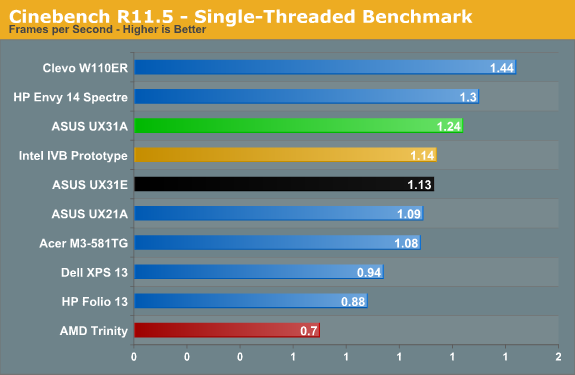
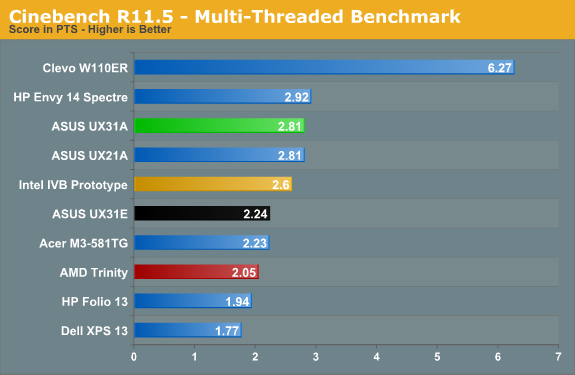
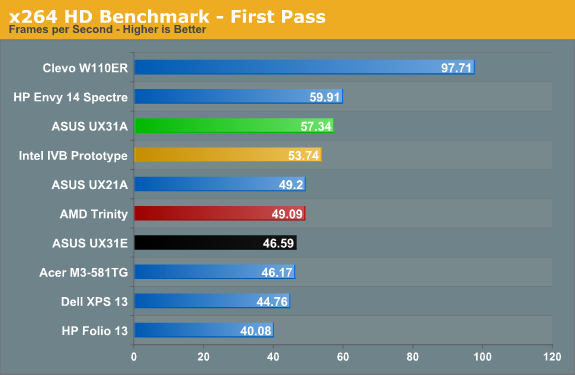
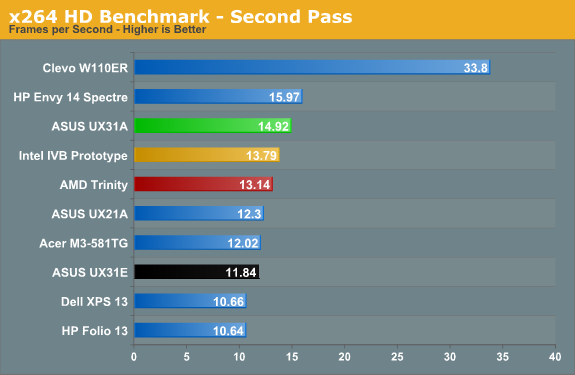
Moving on to the CPU testing side of things, the i7-3517U performs right where you’d expect. A dual-core ULV processor will never match the likes of 45W quad-core Ivy Bridge CPU for raw computational power, but if you’re only doing typical office and Internet related tasks, along with consumption of multimedia, it’s not really a problem. There are definitely applications that will benefit from more CPU performance, but things like 3D rendering (Cinebench) and video editing are only used by a relatively small percentage of users; if you have a desktop in addition to a laptop, that’s likely where you’re going to be doing such tasks. The i7-3517U ends up just slightly faster than the i5-3427U, and there’s really not much of a benefit to the upgrade. Either you can live with ULV performance and the i5 chips, or you’ll need more than the i7 ULV parts can provide.
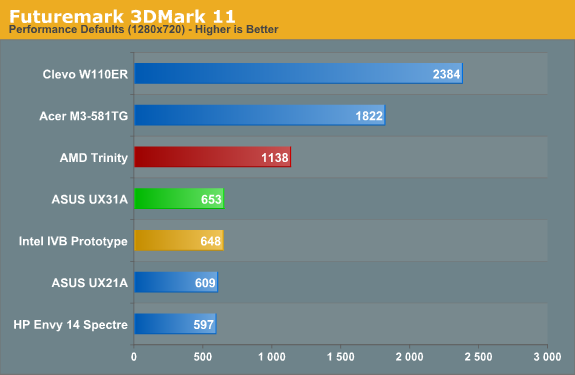
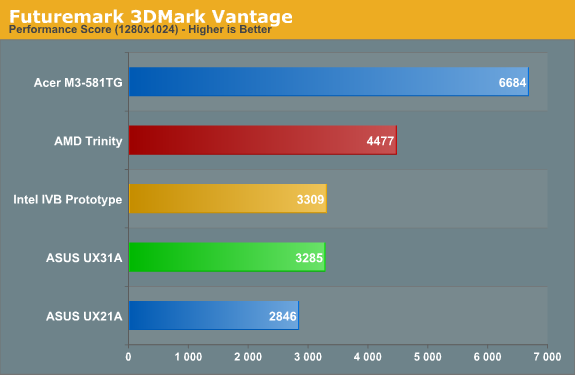
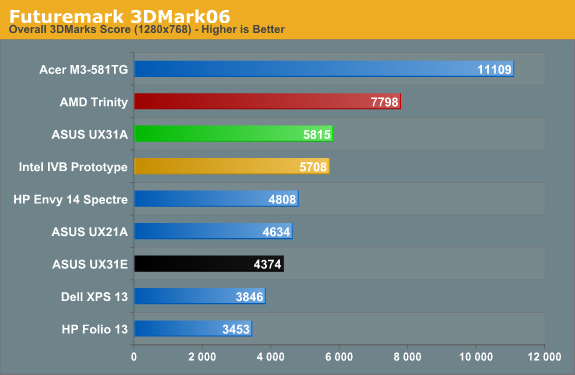
Wrapping up with a quick look at graphics performance, while HD 4000 is certainly a big step up from HD 3000—which in turn was an even bigger step up from Arrandale’s HD Graphics—it’s still nowhere near matching even midrange GPUs like the GT 640M. Ultrabooks are okay for most casual games, but demanding titles will prove too much for the HD 4000, especially when it has to operate within a 17W TDP. If you want an Ultrabook that has a bit more gaming potential, we’d suggest looking at ASUS’ UX32VD (it includes a switchable GT 620M dGPU) or Acer’s updated M5 Ultrabook (with a faster GT 640M LE dGPU). But let’s not base that off of just 3DMark results….










106 Comments
View All Comments
roc1 - Tuesday, August 28, 2012 - link
Thanks for the prompt response!ph2000 - Wednesday, August 29, 2012 - link
isn't the headphone jack is a combo for headphone and microphoneit has 4 pins, same as phone headset
JarredWalton - Wednesday, August 29, 2012 - link
All I know is I plugged in a microphone and while the Realtek control panel popped up a "device connected" message, it didn't allow me to configure the mic -- it set it up as headphones.ph2000 - Wednesday, August 29, 2012 - link
it because normal headphone and mic jack has the same pin arrangementuse an adapter/splitter (TRRS to TRS) to use normal microphone
TRRS = 4 pin
TRS = 2 / 3 pin
something like this
http://www.amazon.co.uk/Startech-com-3-5mm-Headset...
repoman27 - Tuesday, August 28, 2012 - link
Why on earth would ASUS include a mini-VGA port with a VGA adapter instead of a mini DisplayPort with a VGA adapter? I mean I understand an analog output can still be useful from a lowest common denominator standpoint, but if you need a dongle to use it anyway, why not just go mini-DP?I can only assume it has something to do with the Ivy Bridge FDI requiring at least two of the three display outputs to share a pixel clock. Still odd though.
smartypnt4 - Tuesday, August 28, 2012 - link
Will we see a mini-review discussing more in-depth differences between the UX31A and the UX32VD?The upgrade-ability of the UX32VD seems like it would be almost every bit as good as the UX31A in most respects. It addresses the lack of availability of an 8GB upgrade since it has one slot for RAM available for upgrades, and it has a standard SATA 2.5" HDD. It could be argued that throwing an SSD in the UX32VD makes it the best ultrabook money can buy. It's a bit more expensive than the UX31A if you do that, though. But still.
JarredWalton - Tuesday, August 28, 2012 - link
Anand has the UX32VD and is working on that review; I don't know when he'll be finished, though. My biggest issue with the UX32VD is that most of the models lose the 1080p display and the HDD + SSD hybrid solution basically stinks compared to pure SSD. (That latter bit isn't just an ASUS problem, of course.)ka_ - Tuesday, August 28, 2012 - link
That is the laptop I am most interested in! The main reason I will select UX32VD with IPS over UX31 is bad experience "mini" ports - the UX32VD got full size HDMI port. Also the UX32VD have one 2GB ram chip that can be changed with an 8GB giving a total 10GB ram. About pure SSD vs hybrid, I must say I favor hybrid still, though I could just as well bring an external USB 3.0 disk when space is needed. I would have liked to see the UX32VD without a dedicated graphics card - I have an Asus UL30VT currently and I never use the extra dedicated graphics card anyway. It could be interesting to know if the dedicated graphics card can be removed from the unit to save more weight or maybe even replaced with another SSD disk?Conficio - Tuesday, August 28, 2012 - link
Exactly. I'm looking time and again at the UX32? and the options that are affordable and shed the unnecessary GPU, those have a crappy display.Soldered RAM and proprietary SSD are only things for people with too much money. to be honest at this day and age I don't want a built in SSD in the first place. I'd rather buy it after market to have choice over controller and warranty.
I'd even prefer a 14" or 15" version with an mSATA for the SSD and a 2.5" drive bay for the HDD and a beefy battery to boot.
smartypnt4 - Tuesday, August 28, 2012 - link
Oh, no, I agree. I'm more referring to the versions with that excellent 1080p screen.And if I'm spending that much on a laptop, I don't think I'd have a problem finding a 128gb or 256gb SSD to put in it to replace that rather disappointing hybrid combo. That makes it a $1600-1700 laptop, though ($1500 for the laptop and $100-200 for the SSD).
But still. Points for being able to upgrade an ultrabook that isn't too much bigger than the one you reviewed with standard parts.
The only reason I push for a dedicated GPU is because when I find myself wanting it, it's REALLY nice to have. Most of the time, it's not needed. Those edge cases where I actually want one (playing an MMO on the go, etc.) make it worth it though, considering I upgrade laptops about once every 3-4 years at this point.
Then again, this whole argument about a dedicated GPU could be moot with Haswell, which should be awesome from a GPU standpoint for no other reason than the eDRAM, much less the 40% more compute resouces (I think that's right anyway).